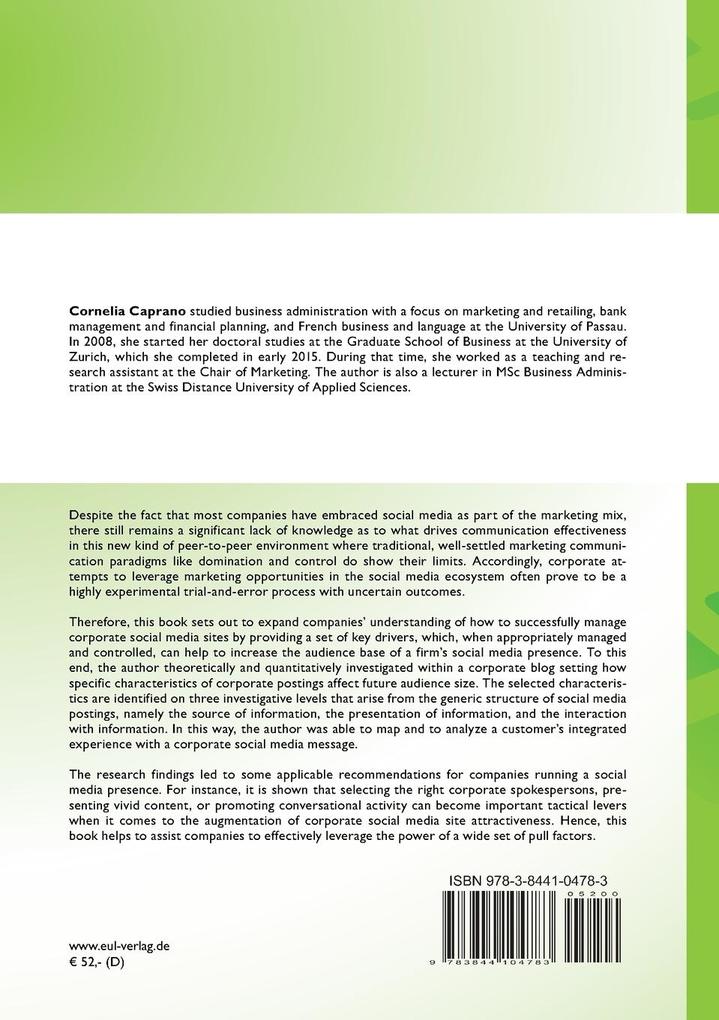
Zustellung: Fr, 27.06. - Mo, 30.06.
Versand in 2 Tagen
VersandkostenfreiBestellen & in Filiale abholen:
Despite the fact that most companies have embraced social media as part of the marketing mix, there still remains a significant lack of knowledge as to what drives communication effectiveness in this new kind of peer-to-peer environment where traditional, well-settled marketing communication paradigms like domination and control do show their limits. Accordingly, corporate attempts to leverage marketing opportunities in the social media ecosystem often prove to be a highly experimental trial-and-error process with uncertain outcomes.
Therefore, this book sets out to expand companies understanding of how to successfully manage corporate social media sites by providing a set of key drivers, which, when appropriately managed and controlled, can help to increase the audience base of a firm s social media presence. To this end, the author theoretically and quantitatively investigated within a corporate blog setting how specific characteristics of corporate postings affect future audience size. The selected characteristics are identified on three investigative levels that arise from the generic structure of social media postings, namely the source of information, the presentation of information, and the interaction with information. In this way, the author was able to map and to analyze a customer s integrated experience with a corporate social media message.
The research findings led to some applicable recommendations for companies running a social media presence. For instance, it is shown that selecting the right corporate spokespersons, presenting vivid content, or promoting conversational activity can become important tactical levers when it comes to the augmentation of corporate social media site attractiveness. Hence, this book helps to assist companies to effectively leverage the power of a wide set of pull factors.
Therefore, this book sets out to expand companies understanding of how to successfully manage corporate social media sites by providing a set of key drivers, which, when appropriately managed and controlled, can help to increase the audience base of a firm s social media presence. To this end, the author theoretically and quantitatively investigated within a corporate blog setting how specific characteristics of corporate postings affect future audience size. The selected characteristics are identified on three investigative levels that arise from the generic structure of social media postings, namely the source of information, the presentation of information, and the interaction with information. In this way, the author was able to map and to analyze a customer s integrated experience with a corporate social media message.
The research findings led to some applicable recommendations for companies running a social media presence. For instance, it is shown that selecting the right corporate spokespersons, presenting vivid content, or promoting conversational activity can become important tactical levers when it comes to the augmentation of corporate social media site attractiveness. Hence, this book helps to assist companies to effectively leverage the power of a wide set of pull factors.
Inhaltsverzeichnis
1. Introduction
2. Contextual Background
2.1. Social Media
2.2. Corporate Weblogs
3. Related Literature
4. Hypotheses Development
4.1. Conceptual Framework
4.2. Source of Information: Author Hierarchy Level
4.3. Presentation of Information: Storytelling and Sensory Elements
4.4. Interaction with Information: Participants, Sentiments, and Conversations
4.5. Overview of Testable Hypotheses
5. Data Description and Modeling Preview
5.1. Data
5.2. Modeling Preview
6. Variable Definitions, Measurements, and Checks
6.1. Variables and Measures
6.2. Robustness Check: Alternative Specification
6.3. Variable Recap and Summary Statistics
7. Empirical Model
7.1. Data Challenges and Modeling Approach
7.2. Model Specification
7.3. Model Extension
8. Model Estimation and Discussion
8.1. Estimation Strategy
8.2. Regression Results
8.3. Interpretation of Coefficients
8.4. Detailed Analytical Insights and Discussion
9. Conclusion
2. Contextual Background
2.1. Social Media
2.2. Corporate Weblogs
3. Related Literature
4. Hypotheses Development
4.1. Conceptual Framework
4.2. Source of Information: Author Hierarchy Level
4.3. Presentation of Information: Storytelling and Sensory Elements
4.4. Interaction with Information: Participants, Sentiments, and Conversations
4.5. Overview of Testable Hypotheses
5. Data Description and Modeling Preview
5.1. Data
5.2. Modeling Preview
6. Variable Definitions, Measurements, and Checks
6.1. Variables and Measures
6.2. Robustness Check: Alternative Specification
6.3. Variable Recap and Summary Statistics
7. Empirical Model
7.1. Data Challenges and Modeling Approach
7.2. Model Specification
7.3. Model Extension
8. Model Estimation and Discussion
8.1. Estimation Strategy
8.2. Regression Results
8.3. Interpretation of Coefficients
8.4. Detailed Analytical Insights and Discussion
9. Conclusion
Produktdetails
Erscheinungsdatum
30. September 2016
Sprache
englisch
Auflage
1. Auflage
Seitenanzahl
156
Autor/Autorin
Cornelia Caprano
Verlag/Hersteller
Produktart
kartoniert
Gewicht
236 g
Größe (L/B/H)
210/148/10 mm
ISBN
9783844104783
Entdecken Sie mehr
Bewertungen
0 Bewertungen
Es wurden noch keine Bewertungen abgegeben. Schreiben Sie die erste Bewertung zu "Effectiveness of Social Media Communication" und helfen Sie damit anderen bei der Kaufentscheidung.










